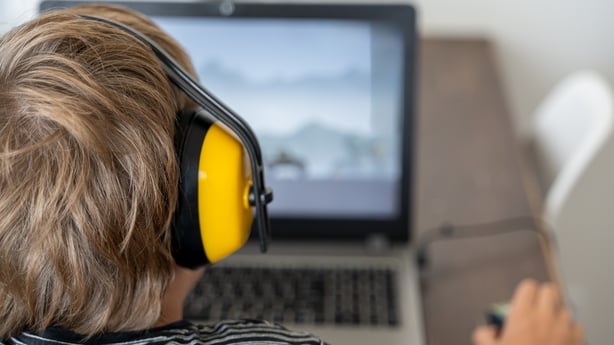Research released this week by an online safety charity showed that a quarter of primary school children aged eight to 12 have been bothered or upset by something they have seen online.
CyberSafeKids' annual Trends and Usage Report 'Left To Their Own Devices' surveyed over 7,000 children in the academic year 2023-24.
Of the eight to 12-year-olds who felt upset over online content, this most commonly occurred on YouTube (37%) and Roblox (23%), even though Roblox is widely perceived as a child-friendly social gaming environment.
Brian O'Donovan takes a closer look at the platform which has become hugely popular with younger children.
What is Roblox?
Roblox is an online platform that allows users to create and play games.
It is free to play and there are in-game purchases available through a virtual currency called Robux.
Roblox describes itself as an "immersive platform" which is one of the safest on the internet, where users create, play and connect with each other in experiences built by a global community of creators.
The platform has exploded in popularity in recent years, particularly among younger children.
Globally, Roblox currently has almost 80 million daily active users.
What are the concerns about Roblox?
The latest research from CyberSafeKids shows that a quarter of eight to 12-year-olds have encountered something online that bothered or upset them, and almost a quarter of them encountered this upsetting material on Roblox.
"Children spoke about harassment, seeing people being harassed in a game, name calling, slurs, bad language, things that made them feel uncomfortable," said Olwyn Beresford, Education Programme Analyst with CyberSafeKids.
Another issue that came up in the CyberSafeKids survey related to horror images and scary games.
"There is a whole genre of games on Roblox that would be considered quite scary," Ms Beresford said.
"Some of the experiences children have in terms of jump scares are quite upsetting, and horror and scary content is what comes through very strongly in our surveys as problematic for children in this eight to 12 age range.
"Being scared is a big one for children and one that maybe stays with them, because we know so many of them keep it to themselves, they then don't get to process it correctly and move on from it. So it's something that kind of festers for them.
"The children also talked about scams linked to trades - the idea that somebody had promised them something in a trade, but they felt they didn't come out of it very well in the end."
If security settings and parental controls are not in place, it is possible for strangers to communicate with children on Roblox.
"There are a lot of different settings on Roblox that you can enable, but looking through our data, it would appear that many children are leaving their sessions quite open.
"So they are communicating with everyone in live chat streams while they immerse themselves in a particular experience or a game," Ms Beresford said.

For many children, Roblox is the first online environment they experience in which they can communicate with other users.
"There's a steep learning curve for many of them when they go into Roblox because they haven't communicated online on other platforms before.
"It very much is a social online platform, even when you take gaming out of it."
According to CyberSafeKids' data, Roblox is particularly popular with girls.
"Overall, 40% of eight to 12-year-olds use the platform, but 54% of girls in that age group are on Roblox," Ms Beresford said.
A gap in regulation
Concerns have been expressed that regulating online gaming environments has not received the same attention as social media platforms on which children spend time.
Gaming sites are not covered by Ireland's Online Safety and Media Regulation Act.
Because many of the gaming platforms fall under certain thresholds of active users, they are not as strictly regulated as other sites under the EU's Digital Services Act (DSA).
Ireland's media regulator, Coimisiún na Meán, is not responsible for regulating gaming platforms like Roblox because their EU headquarters are not based in this country.
"This is a major loophole," said Alex Cooney, CEO of CyberSafeKids.
"They don't come under our national legislation, and for the Digital Services Act, they don't quite meet that threshold of size.
"Either you strengthen the Online Safety and Media Regulation Act to include more child specific measures, or you create a separate piece of legislation, which will also then strengthen the tools and powers of Coimisiún na Meán."

What does Roblox say about safety?
Roblox says that safety and civility are foundational to its platform and that it has a robust set of proactive and preventative safety measures specifically designed to protect younger users.
"In addition to our safety features, we provide a suite of parental controls that enables parents and caregivers to limit chat to a selected list of contacts or turn it off altogether, manage the experiences their kids have access to, and set spending restrictions," a Roblox spokesperson said.
"We will continue to work tirelessly to keep our users safe, and to support young people in developing a set of skills and behaviors which help to create positive online interactions that are respectful, inclusive, and supportive," the company said.
When it comes to content or behaviour on the platform that breaks the rules, Roblox said it takes this extremely seriously, and has put measures in place to "swiftly catch" anyone attempting to circumvent its community standards.
These protocols include pre-publication screening of uploaded images, audio and video files, and 3D models.
The company said it also uses advanced text chat filters to detect and block inappropriate words and phrases.
"Our text chat filters for under-13 users are designed to block attempts to direct such users off platform and prevent the sharing of personal information, such as a phone number or address," the company said.
It added that its community standards are enforced 24/7 by a global team of moderators.
Many parents may be less concerned about sites that are perceived as child-friendly and aimed at younger users.
But when platforms allow access to potentially upsetting imagery or communications from strangers, the same vigilance should apply.
The advice for those in charge of children's online access is to research the sites they are using, and to set the controls and filters they deem appropriate to ensure their internet experiences are enjoyable and safe.







